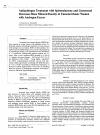Subscribe to RSS
DOI: 10.1055/s-2007-1000771
© Georg Thieme Verlag, Stuttgart · New York
Antiandrogen Treatment with Spironolactone and Linestrenol Decreases Bone Mineral Density in Eumenorrhoeic Women with Androgen Excess
Publication History
1993
1993
Publication Date:
14 March 2008 (online)

Summary
Increased bone mineral density (BMD) has been reported in young women with androgen excess. To determine whether antiandrogen treatment in young women with androgen excess reduces BMD in these patients, the authors measured BMD before and a year after the beginning of antiandrogen therapy with Spironolactone and linestrenol in 17 consecutive androgenized patients (median age 22 years). After a year's treatment BMD declined in 15 out of 17 patients, the mean decrease - 0.032 g/cm2 (95% CI of the difference 0.016-0.048) - being highly significant (p<0.001). Androstenedione decrease was the only hormonal variable significantly correlating with BMD decrease (r = 0.5; p = 0.037) according to simple linear regression.
A decrease of BMD might become a key factor in deciding about the duration of antiandrogen treatment with Spironolactone in functional hyperandrogenemia.
Key words
BMD - Antiandrogen Treatment - Functional Hyperandrogenemia

